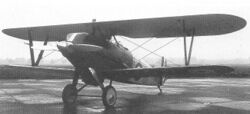Hawker Hornbill
Topic: Engineering
 From HandWiki - Reading time: 2 min
From HandWiki - Reading time: 2 min
| Hornbill | |
|---|---|

| |
| Role | Fighter |
| Manufacturer | Hawker Aircraft |
| Designer | W. G. Carter |
| First flight | July 1925 |
| Status | Prototype only |
| Number built | One |
The Hawker Hornbill was the last Hawker military aircraft designed under the direction of W. G. Carter. The design was started in 1925 and the first flight took place in July 1925.[1] The Hornbill did not achieve service in the Royal Air Force due to problems in its power plant and radiator. Only one aircraft was built.
Construction
The Hornbill had a mixed material construction, having a steel engine mount and front fuselage covered with duralumin sheet. The rear fuselage was made of wood structure covered with canvas. The wings also were of wood and canvas. The engine was a 698 hp (520 kW) Rolls-Royce Condor IV driving a fine pitch wooden propeller.
Performance
The aircraft was very fast but lacking in stability and control. At 150 mph (241 km/h), steep turns could not be made without applying full rudder. Engine overheating occurred during flight tests. The single centrally mounted radiator was replaced by two radiators mounted in the lower inner wings, but the problem was not fully cured. The small size of the cockpit restricted the movement of the pilot.
Specifications (Hornbill)
Data from The British Fighter since 1912[1]
General characteristics
- Crew: 1
- Length: 26 ft 7 1⁄4 in (8.109 m)
- Wingspan: 31 ft 0 in (9.45 m)
- Height: 9 ft 8 in (2.95 m)
- Wing area: 317 sq ft (29.5 m2)
- Empty weight: 2,975 lb (1,349 kg)
- Gross weight: 3,769 lb (1,710 kg)
- Max takeoff weight: 3,800 lb (1,724 kg) (overload)
- Powerplant: 1 × Rolls-Royce Condor IV water cooled V12 engine, 698 hp (520 kW)
Performance
- Maximum speed: 187 mph (301 km/h, 162 kn) at sea level
- Range: 200 mi (320 km, 170 nmi)
- Service ceiling: 22,700 ft (6,900 m)
- Time to altitude: 6 min 30 s to 10,000 ft (3,000 m)
Armament
- Guns: 1 × .303 in (7.7 mm) Vickers machine gun
See also
References
- ↑ 1.0 1.1 Mason, Francis K (1992). The British Fighter since 1912. Naval Institute Press. ISBN 1-55750-082-7.
- Hawker Aircraft since 1920 by Francis K Mason - pub Putnam 1961
 |
 KSF
KSF
